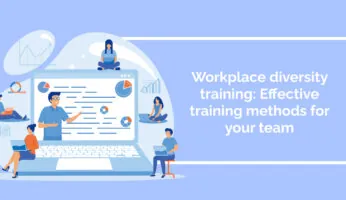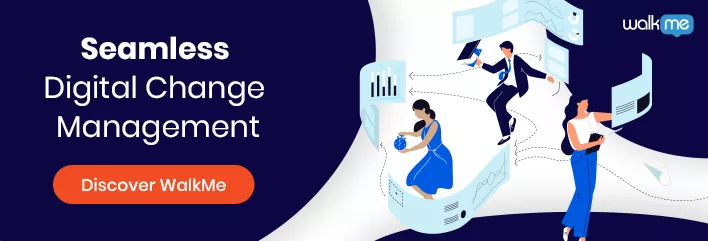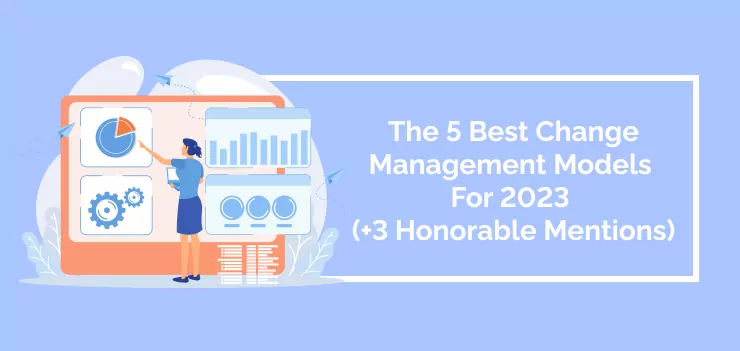
It’s 2023, and change is the new normal.
From consumer demands to market shifts to current affairs— disruptive changes are coming at business leaders like you faster every year. Change is unavoidable.
You have two choices in dealing with those facts: constantly adapt, stagnate, and risk failure.
Within this climate, change management is a business-critical process. The problem is change management can be difficult to get right.
That’s where change management models come in. But finding the best change management model for your business isn’t always straightforward.
To find the perfect change management model, you’d normally need to sift through decades of change management theories. Luckily, we’ve done that for you.
We’ve collated our top 5 change management models for 2023 into this article, so you can make a quick, effective choice to support your change management processes.
Change Management Models: What They Are and Why You Need to Know
Change management models are different ways of coordinating or guiding change management using a set formula based on several factors.
“When I hear the question today, “Why is change so hard?” I would almost turn it on its head and say, “Well, it shouldn’t be easy.” Because at some level, if you think of organizations, these are systems with people in them,” says Kirk Rieckhoff, senior partner at Gartner.
Change management is complex; change management models help you coordinate a strategic vision for your organizational changes. They provide much-needed guidance and structure.
You can use a change management model to home in on problem areas and:
- Reduce the time taken for successful change.
- Encourage changes to stick.
- Transition efficiently, saving time and money.
“… half of […] change initiatives fail, and only 34% are a clear success,” according to Gartner.
Change management models are key to driving that low success rate up.
What is the difference between change management model and change management theory?
Change management model and change management theory are related concepts in the field of organizational change, but they have distinct purposes and applications. Understanding their differences can help clarify their roles in guiding and implementing change within an organization.
Change Management Theory:
Change management theory is a collection of principles, ideas, and frameworks that explain how change occurs in organizations and how to effectively manage it. These theories provide a foundation for understanding the complex nature of organizational change, as well as the factors that influence successful change initiatives. Some well-known change management theories include Lewin’s Change Theory, Kotter’s 8-Step Change Model, and the ADKAR model. These theories address different aspects of change, such as the psychological and behavioral elements, and the processes and stages that organizations go through during change.
Change Management Model:
A change management model is a specific tool or framework that organizations use to plan, implement, and monitor the progress of a change initiative. These models are often derived from change management theories and provide practical, step-by-step guidelines to help organizations navigate the change process. By applying a change management model, organizations can minimize resistance, maintain productivity, and ensure that change is effectively integrated into the organization. Examples of change management models include Kotter’s 8-Step Change Model, the ADKAR model, and the McKinsey 7S Model. These models provide actionable strategies and guidelines for achieving successful change in organizations.
In summary, change management theory offers a broader understanding of the principles and factors involved in organizational change, while change management models provide practical frameworks for planning and implementing change initiatives. Both concepts are essential for effective change management, as they complement each other in guiding organizations through the complex and challenging process of change.
What Makes a Good Change Management Model?
The change management models we list here aren’t your only option— the perfect model for your business will depend on your unique circumstances.
That said, there are a few factors any robust change management model should address. These are:
- Leadership
- Culture
- Employee training
- Staff Resources
Change strategies must include these factors within a robust plan, complete with contingencies.
Change management theory can generally be separated into two types: soft, based on psychology and human behaviors, and hard, based on method, systems, and completing tasks.
Understanding these two types is essential if you decide which approach will work for you.
Bear in mind they’re not mutually exclusive. You can (and should) consider soft and hard factors when choosing a change management model.
The 5 Best Change Management Models For 2023
There’s an overwhelming amount of change management theory out there, so we’ve distilled all that wisdom into a list of the five best change management models for 2023.
We think these five options are well-thought-out and versatile. We’ve also listed some honorable mentions lower down.
1. The McKinsey 7S model
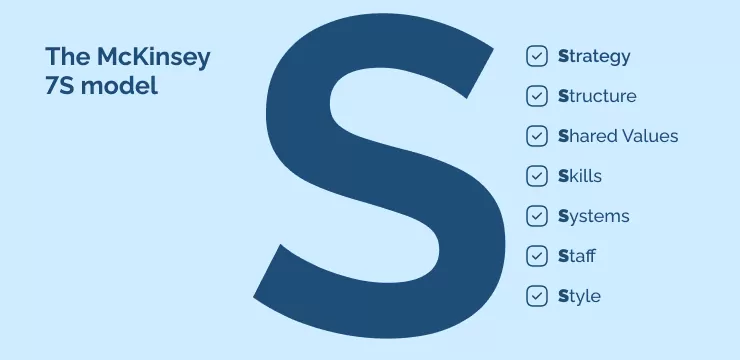
The McKinsey 7S model focuses on coordination rather than organizational structure. A map of interrelated factors (all of which begin with an “S”) assesses a company’s ability to implement change.
The McKinsey 7S model is detailed, comprehensive, and easy to follow. It encourages you to consider soft and hard factors affecting change management.
This model works best within a longer-term change management strategy, but it also contains many elements which encompass the scope for short-term wins.
The “7S” factors are:
Strategy
Strategy is essential for coordinating staff toward successful change management. Ask yourself:
- What does your strategic vision communicate to team members?
- Will it motivate them?
- What incentive is there for staff to make the dream a reality?
If you want to keep staff motivated throughout the change, part of your strategy must take staff interests to heart.
Structure
“Structure” refers to how an organization is designed and operates.
This includes things like the organizational hierarchy, reporting lines, decision-making processes, and the division of labor.
For example, if your organization is experiencing communication issues between departments, you may need to restructure reporting lines or decision-making processes to improve coordination and collaboration.
Shared Values
“Shared values” refer to the core beliefs, attitudes, and values that shape your organization’s culture.
These values are often deeply ingrained in your organization and can influence the behavior and decision-making of everyone within it.
Examples of shared values may include a commitment to customer service, a focus on innovation, or a dedication to teamwork.
These values can be communicated through formal statements such as mission and vision statements, or they may be communicated informally through stories and myths that circulate within the organization.
Skills
“Skills” refer to the capabilities and competencies required to perform the work needed to execute the organization’s strategy.
These skills can include technical skills, such as expertise in a specific area of technology or industry, and interpersonal skills, such as communication, collaboration, and leadership.
Systems
“Systems” are the processes, procedures, and routines that define how work is done within the organization.
This includes formal and informal systems, such as performance management processes, communication, and information management systems.
Staff
can be your most significant obstacle or a powerful catalyst in change management models. This “S” refers to the people within your organization and their characteristics, such as their skills, experience, and diversity.
Staff can make or break a change management strategy through employee resistance, changeability, desire, and shared values.
Tapping into staff attitudes is essential to ensuring a successful implementation phase.
Style
One of the more vague factors, “style,” refers to the leadership style of the organization and its key leaders.
It encompasses how decisions are made, how people communicate, and how the organization’s culture is developed and sustained.
2. Bridges Transition Model
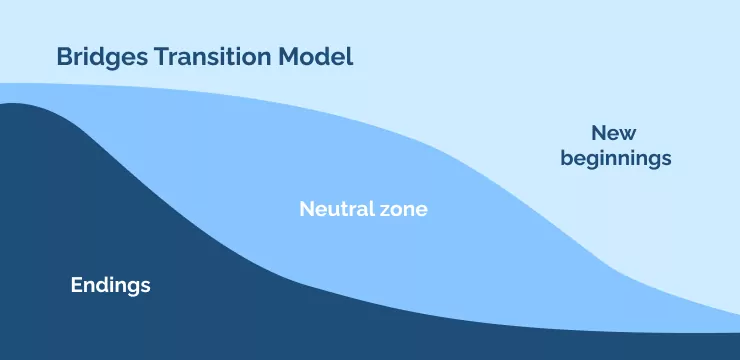
The Bridges Transition model focuses on the human experience of processing and acting on change.
The Bridges Transition model will help you understand the employee experience of processing change but doesn’t outline the systems and processes needed to execute a change.
This model should be combined with a hard model to ensure success.
The three forming principles of the Bridges Transition Model are:
Endings
Every ending is also a beginning.
This point forms the first phase of the Bridges transition model.
The “Endings” phase represents the human act of accepting and managing loss. Within this stage, staff lose some things to a change management strategy and keep others.
It’s essential for those coordinating a change strategy to remember that it can be uncomfortable, even painful, for staff to leave behind the old way of doing things.
By outwardly acknowledging this, leaders strengthen their professional relationships and improve communication.
Neutral Zone
Once the loss is accepted, we transition to the neutral zone.
This zone is where the old culture is out, but the new culture still needs a strong foothold.
Being in the neutral zone is the most critical stage of the transition period. Employees are changing their deeply embedded beliefs and routines and reassessing their values.
This can be a time of confusion, ambiguity, and uncertainty. It’s important to provide clarity and direction during this stage while also encouraging experimentation and exploration.
New Beginnings
New ways of understanding things, new values, and new attitudes all contribute to forming a new sense of the status quo.
When change is well managed, staff members feel liberated and empowered as they begin to understand and act on their new role within a new system.
People may feel a renewed sense of energy and enthusiasm during this stage.
3. Kotter’s Change Management Theory
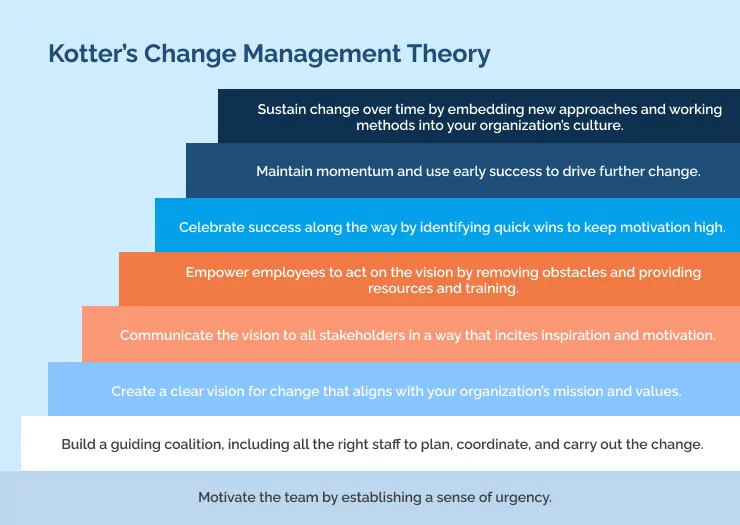
The theory developed by John Kotter is a framework for managing and leading organizational change, and it outlines an eight-step process for effectively implementing change. Here’s a brief overview of each step:
- Motivate the team by establishing a sense of urgency.
- Build a guiding coalition, including all the right staff to plan, coordinate, and carry out the change.
- Create a clear vision for change that aligns with your organization’s mission and values.
- Communicate the vision to all stakeholders in a way that incites inspiration and motivation.
- Empower employees to act on the vision by removing obstacles and providing resources and training.
- Celebrate success along the way by identifying quick wins to keep motivation high.
- Maintain momentum and use early success to drive further change.
- Sustain change over time by embedding new approaches and working methods into your organization’s culture.
Kotter’s change management theory aims to complete tasks, so it can be considered a hard model.
This intensive model could lead to high rates of staff burnout, so it’s best for significant, drastic change within a change management strategy, where massive change needs to occur quickly.
4. Kübler-Ross Change Management Framework
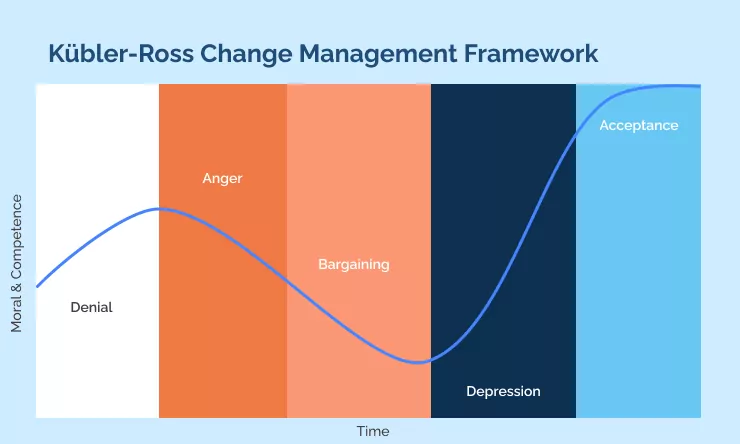
You might be familiar with Elisabeth Kübler-Ross’s work.
This framework should be recognizable to many people as the change model used to explain the five stages of grief.
The grief processes are very similar to the psychological processes of change.
This similarity makes the Kübler-Ross model helpful in supporting employees throughout their reaction to organizational change.
The five stages of the Kübler-Ross model are:
Denial
This stage involves refusing to believe that a change or loss has occurred. People may feel shocked, disoriented, or numb.
Anger
In this stage, people may feel frustrated, anxious, or resentful. They may lash out or blame others for the change or loss.
Bargaining
This involves trying to negotiate or make deals to avoid change or loss. People may feel a sense of desperation or hopelessness during this stage.
Depression
In this stage, people may feel sad, hopeless, or overwhelmed. They may withdraw from others or lose interest in activities they used to enjoy.
Acceptance
This involves accepting the change or loss and finding ways to move forward. People may feel a sense of peace or closure during this stage.
Change management strategies should consider the Kübler-Ross change management model, as it’s helpful for understanding team members’ experiences of change.
The limitation of this model is that it focuses solely on human experience and not on processes. For this reason, it is a soft model, and you may need to use it alongside a hard model.
5. Lewin’s Change Management Model
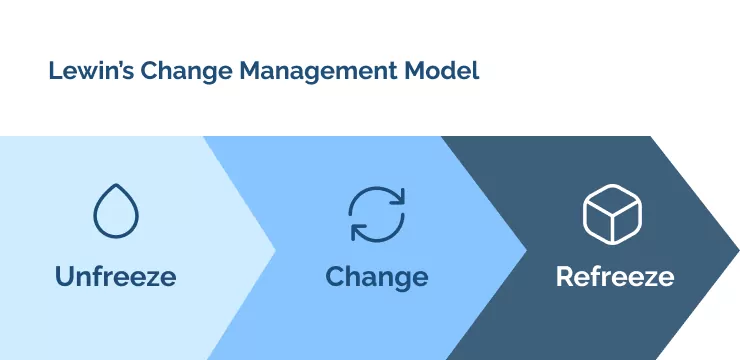
Lewin’s Change Management model is a concise approach to organizational change management.
It’s a hard model that outlines a simple strategy for successful change.
Lewin’s Change Management Model aims to achieve change through three stages:
Unfreeze
This is the preparation stage.
Look at how things operate to see what needs to happen to give you the desired outcome.
Create a sense of urgency and break down the status quo. Create chaos by challenging existing beliefs, attitudes, and behaviors. Only in chaos can you shape change.
Change
This is the implementation stage.
Engage in a process of experimentation, testing, and feedback. This stage might involve training, communication, and support to help employees adapt to new ways of doing things.
Refreeze
Develop a strategy to consolidate your changes and ensure they stick.
Reinforce new attitudes and behaviors to create a sense of stability again.
Analyze the effect of the new changes and measure how close you are to achieving goals set at the “unfreeze” phase.
Like Kotter’s theory, Lewin’s Change Management model focuses on processes and methods and largely ignores the human experience of change.
This makes it a hard change management model.
This theory works well alongside a soft model for longer-term change management strategies and for achieving short-term wins.
Remember that without a soft model monitoring employee experience to some level, adverse effects on employee retention and performance may occur due to burnout.
Change Management Models: Honorable Mentions
If the most popular change management models described above do not fit your enterprise’s needs, don’t worry— there’s more where that came from.
Here are a few honorable mentions of change management models you could consider:
ADKAR Model
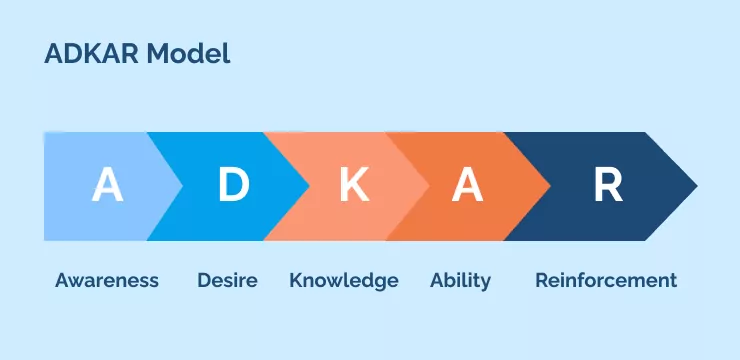
Jeff Hiatt, founder of Prosci, formulated the ADKAR model based on five stages to achieve successful change. This model is a combination of hard and soft models.
Awareness – Make sure all team members know how significant change is for the company.
Desire – Create the motivation and incentive for everyone to want the change.
Knowledge – Give everyone the knowledge they need to carry out their part in creating change. That means training, courses, and education— think “book smarts.”
Ability – Book smarts alone are not enough. Nurture the real-world skills required to support changes through coaching and mentoring. Build confidence, and teach soft skills.
Reinforcement – Reward employees for their efforts to create a sense of accomplishment and reinforce desired attitudes.
The ADKAR model is often used as a tool for managing change at the individual level, helping to ensure that people are prepared for and able to make the necessary transitions.
Satir Change Model
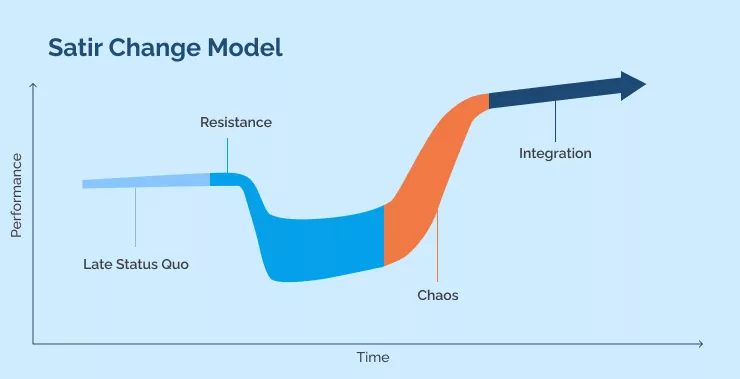
Pioneered by therapist Virginia Satir, The Satir change model uses a soft lens to view change.
Satir initially intended the model for studying how families go through the change process. It can be categorized into the following steps:
1. Late Status Quo
This stage represents the existing state of your organization before the change process begins.
Stakeholders may feel comfortable with things, but may also experience frustration, disappointment, or dissatisfaction.
2. Resistance
This stage is characterized by resistance to change, as employees may feel threatened or unsure about what the change will bring.
This resistance may take the form of denial, anger, or frustration.
3. Chaos
In this stage, the old ways of doing things have been dismantled, but the new ways have not yet been established.
This stage can be characterized by confusion, uncertainty, and a sense of loss.
4. Integration
This final stage involves the establishment of a new status quo.
Employees have accepted and integrated the changes and are now able to move forward with a sense of purpose and direction.
Nudge Theory
Nudge theory is an exception to this list, as it is not a step-by-step model and does not involve any phases.
Rather, Nudge theory is a top-down approach to implementing change via a certain mindset.
The idea is that staff are nudged to encourage desired behaviors through small, low-cost interventions— without removing their freedom of choice.
The theory is based on the idea that people are not always rational decision-makers and are often influenced by unconscious biases, emotions, and social norms.
For example, placing healthy food options at eye level in a cafeteria or framing a message emphasizing the positive benefits of a particular behavior can nudge people towards more nutritious choices.
Similarly, a simple reminder or prompt can nudge people toward completing a particular task or making a specific decision.
Choosing The Right Change Management Model for Your Enterprise Needs
When choosing a change management model, remember there’s always room for experimentation and research.
What may work for you may not work for another.
It is important to develop a well-founded understanding of how your business functions and what changes it needs.
Separating the change management models into ‘soft’ and ‘hard’ categories can help decide which model suits any situation. Still, the best chance of success comes from combining the wisdom of multiple change management models.
In general, a hard change management model helps you get stuff done.
In contrast, a soft change management model gives you a more holistic approach, leading to better communication, staff relationships, accountability, and fulfillment of your vision.
Tristan Ovington
Tristan Ovington is a professional senior writer and journalist, specializing in providing expert insights on various topics such as digital adoption, digital transformation, change management, and Cloud apps. He delivers his knowledge through accessible online content that is data-driven and presented in a friendly tone, making it easy for readers to understand and implement.


